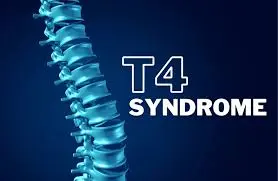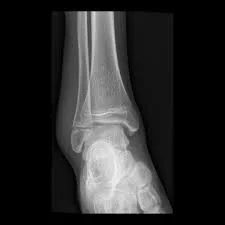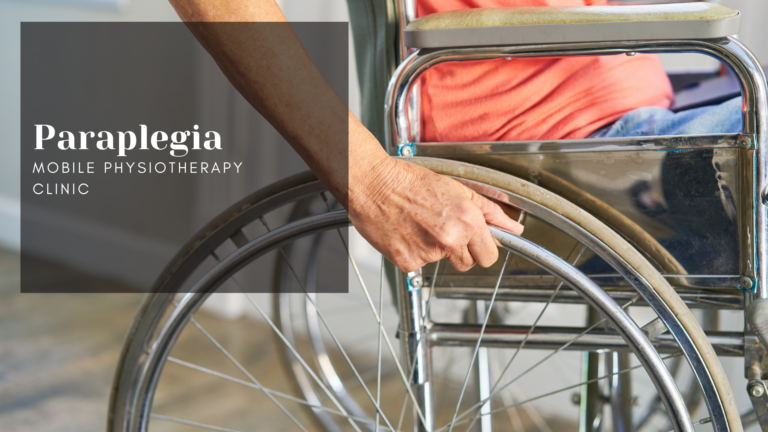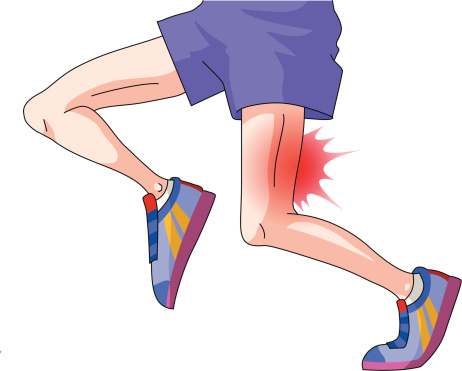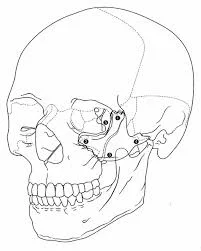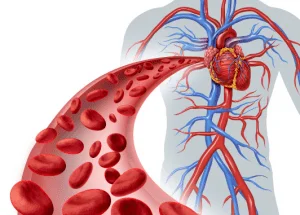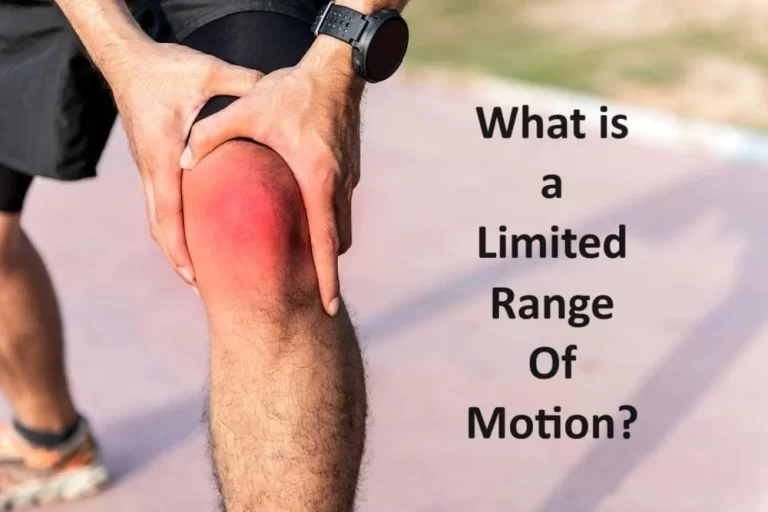T4 Syndrome
Table of Contents
What is T4 syndrome?
- T4 syndrome is a diagnosis of exclusion when all other diagnoses don’t fit the clinical pattern. It is a rare occurrence of symptoms involving upper limb(UL) paresthesia, weakness with reduced thoracic movement, and tenderness on palpation of the T4 vertebra.
- It was originally theorized this symptom exists because of sympathetic nerve fibers converging at T4. Its thought that the head and neck are provided with sympathetic outflow from T1 to T4. An upper trunk and limbs are thought to be supplied by T2 to T5. This could account for the symptoms in the neck, head, and upper limbs(UL).
Clinically Relevant Anatomy
- A typical thoracic vertebra has a total of six joints with a neighboring vertebra: four synovial joints and two symphyses.
- There are two major types of joints between a vertebrae
- Symphyses between vertebral bodies
- Synovial joints between articular processes
- In thoracic regions, the joints are oriented vertically and limit flexion and extension movement, but facilitate rotation
- The thoracic spinal nerves mostly innervate respiratory, visceral, and lower back areas however, T1 and T2 also provide some of the upper limbs.
Epidemiology
- A T4 syndrome is a rare occurrence with little high-quality evidence to prove it as a diagnosis so caution should be used when diagnosing this as the primary pain driver.
- Given the anatomical complexity of the thoracic and shoulder regions, the potential sources of pain in this region are numerous.
- In a worst-case scenario, red flag questions to rule out long-standing visceral issues should be asked specifically regarding:
- Cardiac
- Respiratory
- Renal
- Gastroesophageal conditions
- Cancer
Symptoms of T4 syndrome
- A T4 syndrome is an exclusion diagnosis: once other issues have been excluded then it can be indicative of a T4 syndrome.
- Symptoms can arise following a change in normal routine i.e. new job or hobby. These signs and symptoms could be the result of thoracic dysfunction and it is influence on the sympathetic nervous system.
- Typical presentation includes:
- Paresthesia to the upper limbs(UL) and hands in a “glove” presentation
- Neck pain
- Headaches
- Upper limb pain (bilateral or unilateral)
- Pain around the T4 area
- Scapular pain
- Reduced hand dexterity
- “Heaviness” in upper extremities
- Hands swollen
- Thoracic spine stiffness
- Tenderness on palpation of the T4 vertebra
Less common symptoms:
- Pain around the chest wall
- Worse pain at night
- Pain on deep breathing
- Pain on coughing or sneezing
- Symptoms are often diffuse and located in the neck, head, and upper limbs (unilateral or bilateral)
Diagnostic Procedures
- A T4 syndrome is an exclusion diagnosis with no validated clinical criteria to assist the diagnosis
- The radiographs are no aid in the diagnosis but may help with ruling out other conditions.
- A subjective and objective assessment can also help to aid in excluding other diagnoses.
Examination
- There is no evidence about examinations that include a T4 syndrome. Unfortunately, a great deal of literature exists on shoulder pain, yet little exists on the part of periscapular or rib pain.
- It could be concluded that the intervertebral joint around T4 is hypomobile in patients with T4 syndrome.
During the objective examination it can be useful to assess:
- An overall observation of the patient’s posture in sitting, standing, and provocative movements
- Thoracic active range of motion(AROM)
- Cervical active range of motion(AROM)
- Shoulder active range of motion(AROM)
- Passive thoracic and cervical active range of motion(AROM)
- Shoulder and cervical strength
- Neurological assessment – (dermatomes, myotomes, reflexes) to determine whether nerve root or peripheral nerve lesions are present.
Differential Diagnosis
Red flag questions should be asked extensively to find out any cardiac, respiratory, or visceral problems. Thoracic pain is also common with cancer metastases so earlier to any manual therapy make sure to find out if cancer is the cause of pain. After red flags are cleared its then necessary to find out another differential diagnosis especially in potential T4 syndrome as this is an infrequent condition, therefore, other diagnoses are more likely These can include:
- Thoracic Outlet Syndrome
- Carpal tunnel syndrome
- Ulnar nerve entrapment
- Cervical disc disease or degeneration
- Visceral disease
- Neurological disease
- Fibromyalgia
- Myelopathy
- Causalgia (Complex Regional Pain Syndrome)
- Cardiac disease
Medical Treatment of T4 syndrome
- After excluding other conditions including ruling out red flags and differential diagnosis, pain treatment should begin.
- This should follow a standard ladder of analgesia however, if neurological symptoms are present it can be helpful to prescribe gabapentinoids or if the pain is ongoing consider intramuscular injections of 1 to 2 mL of 0.5% bupivacaine at a fourth thoracic paraspinal level.
Physiotherapy and conservative management are primary treatment options.
Physical Therapy Treatment in T4 syndrome
- After analgesia has been upgraded and if the pain is still an issue with functional deficits, physiotherapy will primary treatment option for T4 syndrome. Different types of manual therapy techniques have been shown to have some effect on the relief of the symptom.
- Thoracic joint mobilization techniques are the basics for treating T4 syndrome.
- These mobilizations have been shown to have analgesic mechanisms because of their effect on the sympathetic nervous system.
- Joint Manipulation
- A passive, high velocity, low amplitude thrust is applied to the joint complex within its anatomical limit with the intent to regain optimal motion, and function, and/ or to decrease pain.
- Joint Mobilisation
- The manual therapy technique comprises a continuum of skilled passive movements to the joint complex that is given at varying speeds and amplitudes, which can involve the small-amplitude/high-velocity therapeutic movement (manipulation) with the intent to regain optimal motion, and function, and/ or reduce pain.
- Soft tissue mobilisation
- Light pressure or slow skin rolling techniques have been shown to have analgesic effects in a short term
Goals of Soft Tissue Mobilization:
- Break down or decrease adhesions
- Increase range of motion
- Lengthen muscles and tendons
- Decrease swelling and edema
- Reduce pain
- Restore functionality
Soft Tissue Mobilization Techniques
Physiotherapists are specially trained to use their hands to push, pull and knead muscles, ligaments, tendons, and nerves in precise ways to help bring the patient relief from pain and return the patient to functionality. Specific techniques for soft tissue mobilization include,
- Sustained pressure: Pushing straight on a restricted tissue and holding.
- Unlocking spiral: Pushing on an affected tissue in alternating clockwise and counterclockwise rotating movement.
- Direct oscillations: Rhythmic pushing on an affected tissue
- Perpendicular mobilization: Pushing on a myofascial tissue at right angles
- Parallel mobilization: Pushing along with the seams of muscles
- Perpendicular strumming: Rhythmic pushing along with the muscle border, followed by the rubber on top of a muscle
- Friction massage: pushing across the bulk of muscles, tendons, and ligaments
Massage
Effleurage (Stroking)
The hands are passed rhythmically and continuously over the patient skin, only in one direction, with the goal of increasing blood flow in that direction, stretching the tissues, relaxing the patient, and aiding the dispersal of the waste products.
The word effleurage comes from French, meaning “to skim”.
This includes stroking movements of the hands sliding over the skin and is normally the first and last technique (as well as being used between other techniques) applied in the massage session.
Effleurage can be used with different tempos and pressure based on the stage of the condition and whatever the desired effect of a massage is.
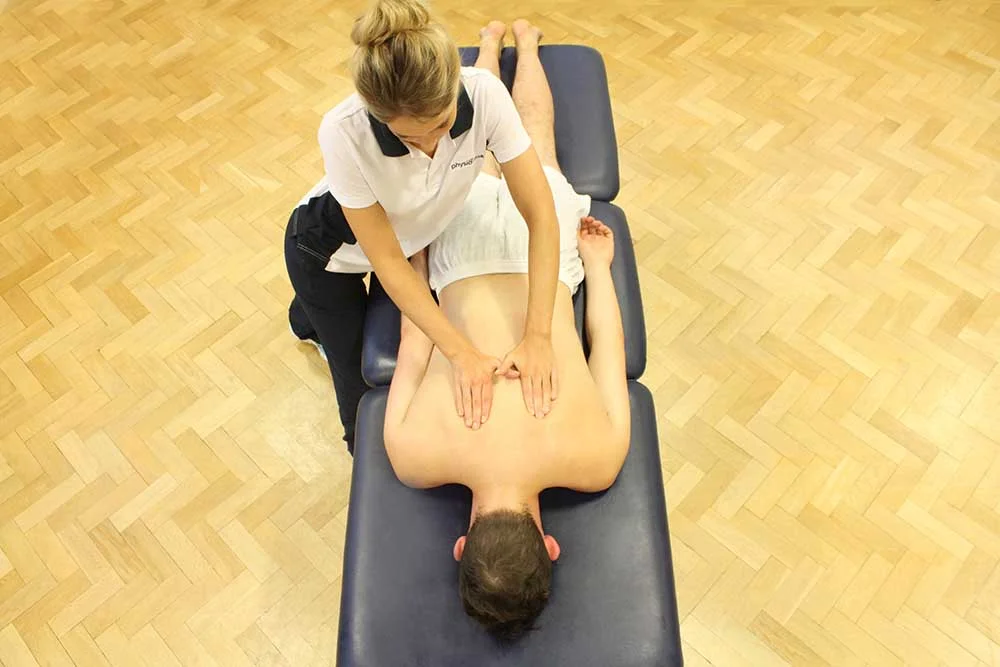
Petrissage (Kneading)
- A skin is pulling up, pressed down and squeezed, pinched and rolled.
- Alternate squeezing and relaxation of the tissues stimulate local circulation and can have pain-relieving effects on some muscular-related disorders.
- Petrissage is coming from the French word, meaning “to knead”.
- The basic motion is to compress, pick up and then release soft tissues.
- Its usually used when a deeper effect than effleurage is desired, and it is techniques include:
- Squeezing
- Picking up
- Shaking
- Rolling
- Wringing

Percussion/Tapotement Manipulations
It includes hacking, clapping, beating, pounding, or vibrations.
Myofascial Release
- Myofascial release is the manual technique for stretching the fascia pointing to release fascia restrictions.
- Fascia is located between the skin and the beneath structure of muscle and bone and joints are the muscles, organs, and skeletal structures in the body.
- Fascia can become affected by injuries, stress, trauma, and poor posture.
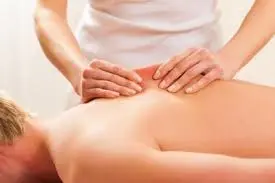
Trigger Point Therapy
- Trigger point therapy includes the applying of pressure to tender muscle tissue in order to reduce pain and dysfunction in other parts of the body.
- Trigger points are active centers of hyperactivity of the muscle, which mostly cross over with acupuncture points.

Deep Transverse Frictions
- Transverse frictions are transverse connective tissue therapy applied directly by your fingers.
- Oscillating pressure is given across the direction of tissue fibers.
- Most commonly used on tendon or ligament injuries to help break down thickened, pain-producing scar tissue.
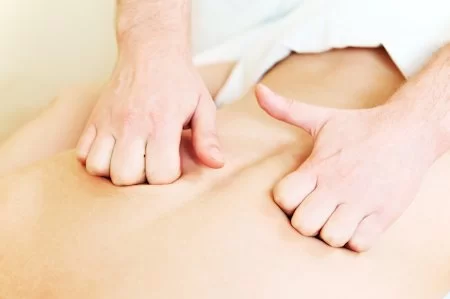
Swedish Massage
Swedish massage therapy incorporates long strokes, kneading, friction, tapping, percussion, vibration, effleurage, and shaking motions. The sequence of use is usually,
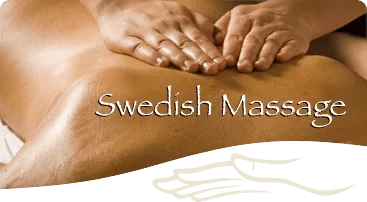
- Effleurage: Gliding strokes with a help of palms, thumbs, and/or fingertips
- Petrissage: Kneading movements with a help of hands, thumbs, and/or fingers
- Friction: Rotational pressures by using the palms of hands, thumbs, and/or fingers
- Vibration: Oscillatory movements that shake or vibrate a whole body
- Percussion: Brisk hacking or tapping
- Passive and active movements: Bending and stretching
Exercise therapy
Shoulder roll
- Begin with standing with the arms down at the sides.
- Roll the shoulders backward in the pendular motion, completing five rotations.
- Then complete five rotations forward.
- Do it further for sequence 2 to 3 times.
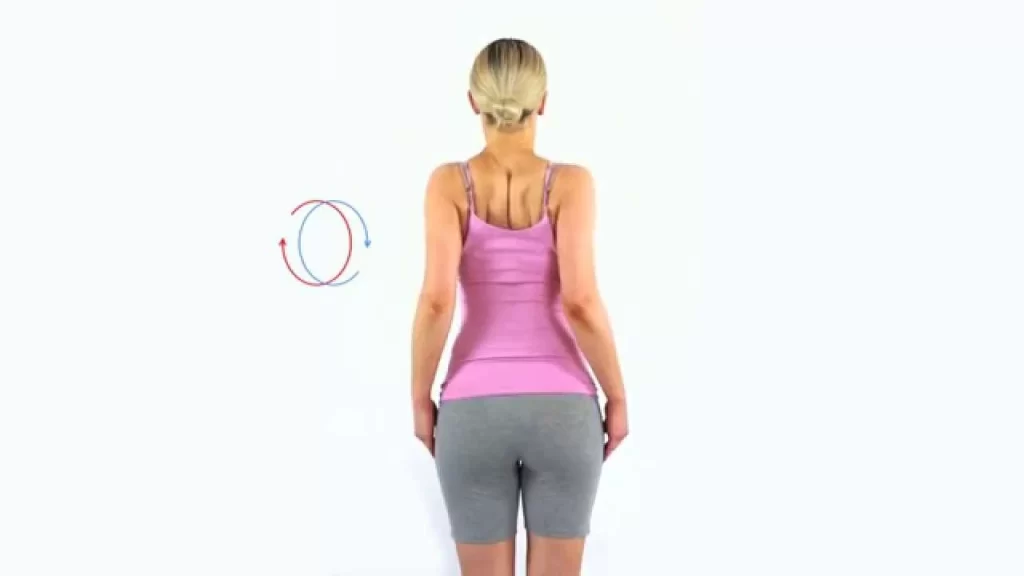
Arm circles
- Start with standing with the arms out to the sides, parallel to the ground, with the palms facing down.
- Gently circle the arms forward, making small circles in starting and eventually larger ones.
- Do it 10 times.
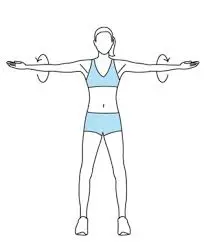
Overhead arm reach
- Start with sitting in the chair, or standing, facing forward, with the feet on the floor.
- Extend one arm above the head and reach to your left.
- Bend the torso until a person feels the stretch in the right lattisimus and shoulder.
- Return to the starting position.
- Repeat five times, then perform the same thing with the opposite side arm.
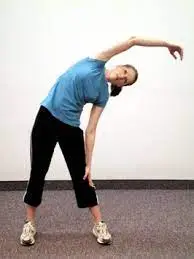
Chair rotation
- Start with sitting sideways in the chair.
- One side should be resting against the back of a chair.
- Keeping the legs stable, rotate the torso to the right, reaching for the back of the chair with your hands.
- Hold the upper body in the rotation, using the arms to stretch deeper and deeper as the muscles loosen.
- Hold for ten seconds.
- Repeat three times on both sides.
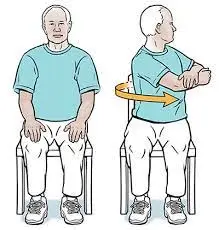
Cat-Cow
- Start on all fours with the neck in neutral.
- The palms should be directly under the shoulders, and the knees should be directly under the hips.
- On a breath in, tuck the pelvis and round out the mid back.
- Draw the navel toward your spine and drop the head to relax the neck.
- After five to ten seconds, breathe out and return to a neutral spine position.
- Turn the face toward the ceiling, allowing the back to sink toward the ground. Hold for five to ten seconds.
- Repeat the sequence 3 to 5 times.
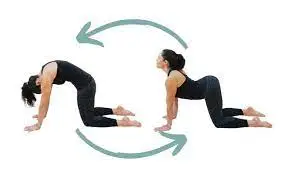
Knee to chest
- Start with lying faceup on the ground.
- Bend one leg and take it to your chest.
- Hold for 10 seconds and then release.
- Repeat with the other side leg.
- Complete the sequence 5 times.
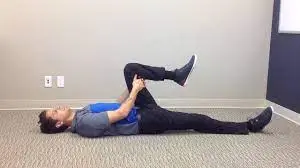
Thoracic extension
- For best results, the person needs the foam roller or a chair.
- If the person using the foam roller, position it under the thoracic spine.
- Allow your head and glutes to fall on either side.
- Extend the arms above your head to deepen the stretch.
- If the person using the chair, sit facing forward and permit the upper body to fall over the back of the chair.
- Extend the arms above your head for a deeper stretch.
- Hold either position for some seconds, then release.
- Repeat three to five times.
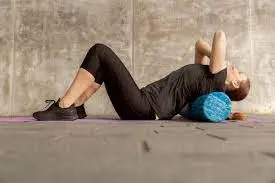
Strengthening exercises
Strengthening the muscles in the back, shoulders, and neck is vital to reduce and prevent pain. Some of these moves contain dumbbells or resistance bands, and some use just the body weight.
Row
You can use a thera band or a light to medium dumbbell to complete this move.
- theraband row
- Affix the thera band to the pole or another stable surface and grasp each handle, extending the arms.
- Pull the handles straight back by bending the elbows, keeping them close to your body.
- They should feel the latisimus working.
- If the person using a dumbbell, hold it in one hand and brace yourself on the wall with another hand, arm extended.
- allowing the dumbbell to hang downward.
- Keeping the neck neutral and the knees soft, pull the dumbbell directly up with the tucked elbow.
- you can do three to five sets of ten repetitions.

Face pull
- Use the thera band to complete this move.
- Stable the thera band to a firm surface above eye level.
- Then grab each handle with an overhand grip.
- Pull directly toward the face, flaring the upper arms out to the sides and squeezing your shoulders together.
- Stop, then back to the beginning position.
- Complete three sets of ten repetitions.
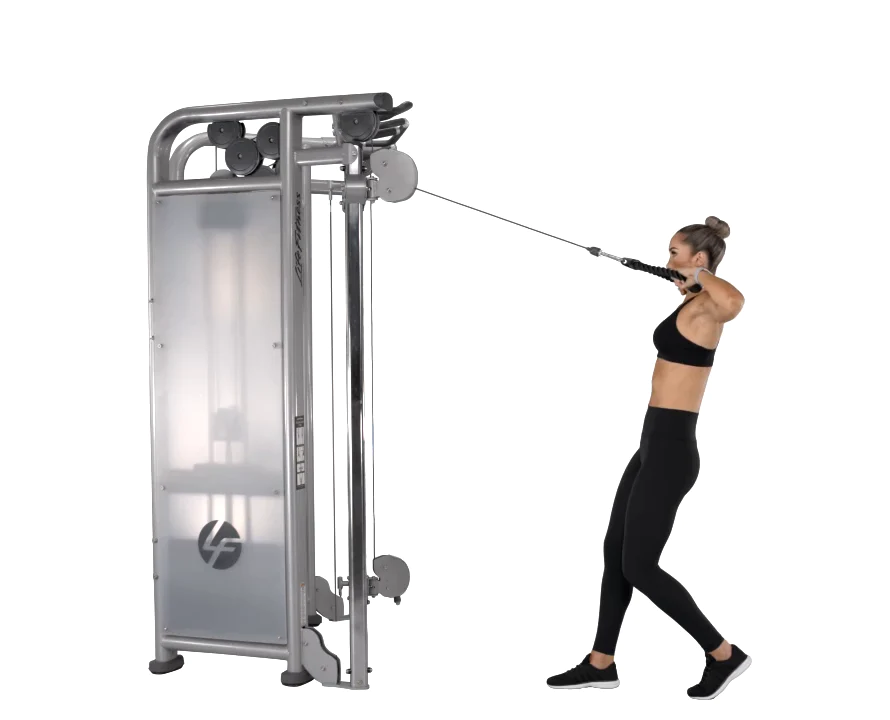
Scapular squeeze
- While standing with the arms down by the sides, squeeze your shoulder blades together.
- Hold for 3 to 5 seconds and then release.
- Repeat five to ten times.
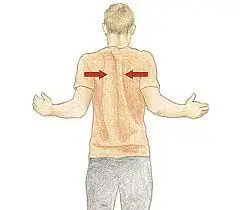
Wall angel
- Stand with the back flat against the wall.
- The person can require stepping her feet out slightly to allow the back to completely soften against the wall.
- Extend the arms out to create a “T” shape against a wall, then bend your elbows to create 90-degree angles.
- Gently move your arms up and down in a “snow angel” motion, ensuring that they stay flat against a wall the whole time.
- When the fingers touch above your head, return to the starting position.
- Complete three sets of ten repetitions.
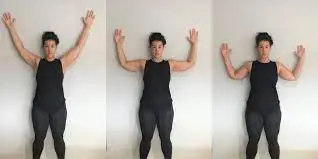
Reverse dumbbell fly
- You can take two light dumbbells and stand, hinged at the waist at a 45-degree angle, with the arms hanging straight downwards.
- Keeping your neck neutral and the gaze down, start to lift the arms out to the sides and up.
- Squeeze your shoulders in one sync at the top of the movement.
- Complete 3 sets of ten to twelve repetitions.
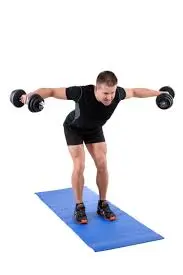
Lat pulldown
- Sit or stand beneath a resistance band attached to the stable surface overhead.
- Pull down on the band until the upper arms are parallel to the ground.
- Pause at the bottom, squeezing the lats, then return to the starting position.
- Complete 3 sets of ten to twelve repetitions.
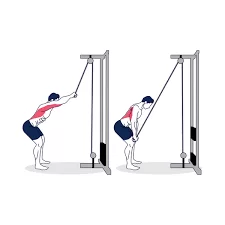
Superman position
- Start with lying on your stomach with the arms extended above the head.
- Keeping the neck neutral, lift the arms and legs off the ground at the same time.
- Make sure the person is using the back and glutes to lift.
- Stop briefly at the top, then return to the starting position.
- Complete three sets of ten repetitions of the superman exercise.
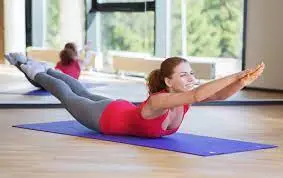
Stretching exercise
Child’s Pose
- Start on the ground on all fours.
- With the big toes touching, spread the knees as far apart as they will go and sit the glutes back onto your feet.
- Sit straight with your arms extended above your head.
- On the next exhale, hinge at the waist and drop the upper body forward between your legs.
- Permit the forehead to touch the ground, the shoulders to spread, and the glutes to sink back.
- You may hold for at least ten seconds.

Butterfly
- Put your palms on opposite shoulders and bring the elbows together to touch.
- You can hold for 10 to 15 seconds and then release.
- Repeat three to five times more.
- Then reverse the movement and do a further 10 circles.
Upper trapezius stretch
- While standing straight or sitting in the chair, take one hand and place it on the back of your head.
- Take the hand and tuck it behind your back.
- Using the other hand, slowly pull the head toward your right shoulder.
- You can hold this for ten to fifteen seconds.
- Repeat on the other side also.
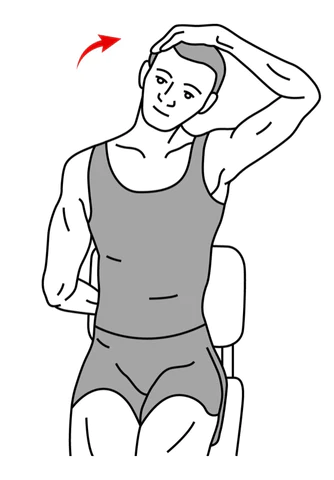
Levator scapulae stretch
- While standing straight or sitting in the chair, turn the neck 45 degrees to the left.
- Bend the neck downward (imagine the person looking into a shirt pocket).
- A person may use the left hand for the greater stretch.
- You may hold this for ten to fifteen seconds.
- Repeat on the other side also.
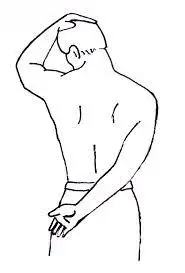
Functional movements
Downward Dog
- It is used by strength experts and yogis alike, this is another useful mobility exercise for thoracic extension and opening up the front of the shoulders.
- Start in the plank position.
- Breathe out to push the hips up, away from the ground, and bend at the hips until a person makes an upside-down Inhale to press the chest through the arms towards your legs.
- Breathe out to shift the weight forward, returning to the plank position again.
- Repeat five times.
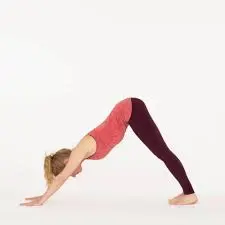
Windmill
- This is a fantastic choice for many ability levels, since a person lying on the ground.
- Start with lying on the ground on one side of the body with the knees bent and stacked in front of the hips.
- The arms should be straight out in front of you at height of the shoulder, and also stacked.
- Keeping your legs together, reach the top arm up toward your ear, and continue to circle it up over the head, opening the shoulders and chest toward the sky, until the arm is reaching the opposite direction from where it started.
- Turn the gaze to follow your moving arm.
- Stay in this position and take two to three deep breaths, then slowing retrace the movements, moving the arm, head, chest, and shoulders back to the starting position.
- Repeat three times, then perform five reps on the other side also.
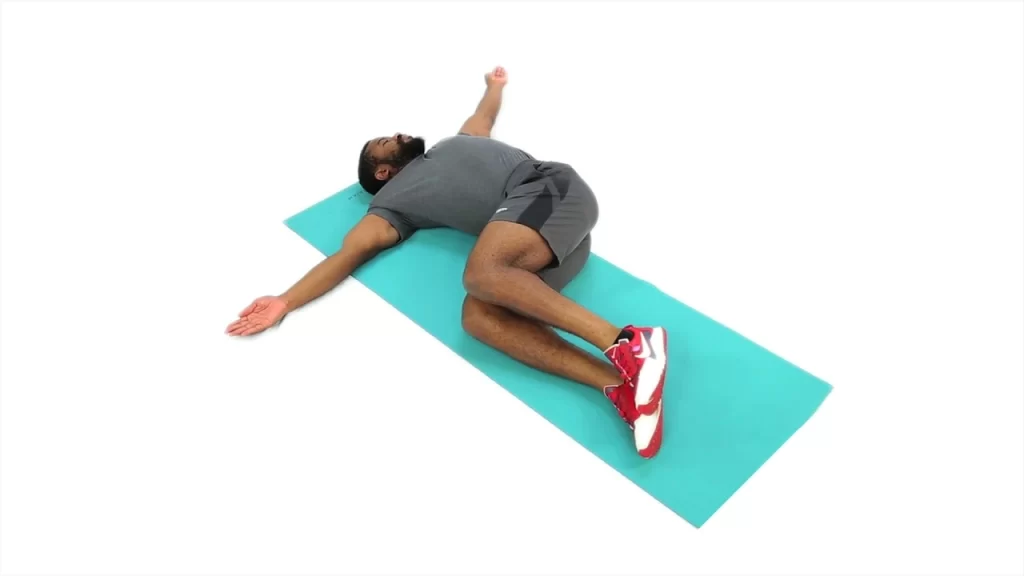
Assisted thoracic extension on a foam roller
- Put the roller on the ground horizontally and sit in front of it, facing away from the roller.
- Lean against it so the bottom of your shoulder blades is resting on it.
- Put the hands behind the head to support your neck.
- By using your breath, open your chest and bend backward over the roller, forming an arc in your upper back.
- If the neck feels supported, release your hands to reach the arms up and back as well.
- Stay here and breathe deep into all sides of the rib cage, permitting the body to soften toward the ground.
- Stay for a breath or two and then return the arms to your side.
- Repeat three to four times.
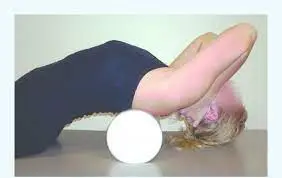
Child’s Pose with an exercise ball
- The Child’s Pose with an exercise ball exercise will open the chest while maintaining support for the entire arm throughout the twist.
- Start with kneeling on the ground facing an exercise ball.
- Sit back on the heels and open the knees wider than your hips.
- Put both hands on the exercise ball and roll it forward until the person bending forward as if in a child’s pose.
- Bring the chest as low as you may toward the knees without pain in your shoulder.
- Breathe in, in this position for two deep breaths.
- Then, keeping up two hands on the ball, roll the ball to the right side so that the chest is opening to the ride side. Looking under one arm, focus on breathing and lengthening your spine.
- Return to the center then repeat the twist to another side also, looking under the other arm.
- Repeat to the center and then roll up to the beginning position, one vertebra at a time.
- Complete 3 to 5 repetitions on both sides.
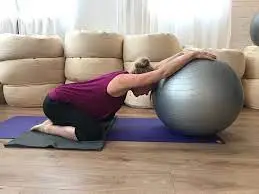
Side Angle Pose (Parsvakonasana)
- Start with Sitting on the edge chair with the legs wide open.
- Straighten one leg to create a lunge-like position in your limbs.
- Keeping up your spine straight, lean over the bent leg, slide the arm down the lower leg toward your ankle, and reach the arm towards the ground.
- On the inhale lift the opposite arm up and over your head, reaching it to the sky or to the opposite.
- Keeping up the lifted arm straight, focus on opening your arm and chest and look up toward the ceiling.
- Exhale to return to the beginning position, lifting back up to the seated position with both legs bent.
- Repeat on the opposite side also.
- Complete three to four repetitions on each side.
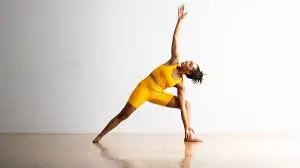
FAQ
T4 syndrome is a musculoskeletal-related dysfunction in which neurological structures get affected. This is caused by the thoracic vertebrae being hypomobile, causing impingement on your nerve fibers. Hypomobility may be caused by hunched posture, immobility, or arthritic-related disease, and is inherited by genetics.
There are many techniques and modalities we can use to fix T4 pain, Chiropractic adjustments, Soft tissue work on the upper back and neck muscles, Ultrasound, Transcutaneous electrical nerve stimulation(TENS) unit, Postural exercises, Stretching muscles of the chest, Strengthening muscles of the upper back, At home exercises to keep good posture.
Paresthesia to the upper limbs(UL) and hands in a “glove” presentation, Neck pain
Headaches, Upper limb pain (bilateral or unilateral), Pain around the T4 area, Scapular pain, Reduced hand dexterity, “Heaviness” in upper extremities, Hands swollen, Thoracic spine stiffness, Tenderness on palpation of the T4 vertebra, Less common symptoms:
Pain around the chest wall, Worse pain at night, Pain on deep breathing, Pain on coughing or sneezing, Symptoms are often diffuse and located in the neck, head, and upper limbs (unilateral or bilateral)
T4 syndrome can be successfully treated with physiotherapy and therefore it is important to see a physiotherapist as soon as you notice any of the symptoms. You should rest from any movements which cause pain and other neurological symptoms. Ice can be used on the affected parts to help reduce any swelling.
The person would be quite likely to regain the ability to walk, although it can be very important to use supporting devices for some period of time before a person may walk unassisted. Another factor connected with whether or not a person can walk again would be the severity of the injury to the spinal cord.
A T4 vertebra has nerves controlling the gallbladder and a common duct, though it affects the lungs and bronchial tubes moreover. As a result, T4 pain symptoms can show themselves in gallbladder trouble, gallstones, and jaundice.

